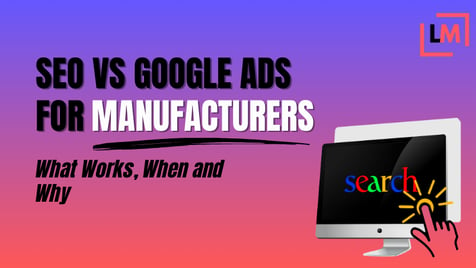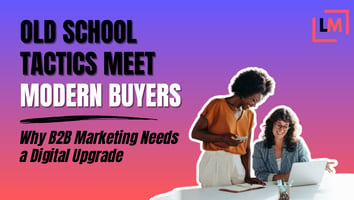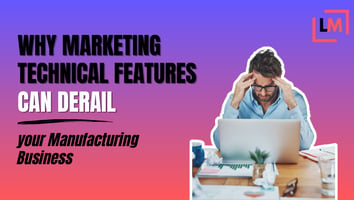Let’s get one thing straight: referrals, trade shows, and cold calls still work. But they no longer...
SEO vs. Google Ads for Manufacturers: What Works, When, and Why

Every manufacturer wants more inbound leads. But when it comes to getting found online, most are left wondering:
Should we invest in SEO? Run Google Ads? Do both?
And if your target audience is highly specific—say, medical device engineers or thermoforming buyers—the path to results isn’t always clear.
This guide will help you understand the difference between SEO and Google Ads, and how to decide what makes sense for your market, budget, and buyer behavior.
🚦 The Basics: Key Differences Between SEO and Google Ads
| Feature | SEO (Search Engine Optimization) | Google Ads (Pay-Per-Click) |
|---|---|---|
| Timeline | Long-term (3–6+ months) | Immediate (starts as soon as your campaign goes live) |
| Cost Model | Time/labor-intensive but no direct cost per click | You pay for each click (bids depend on keyword competition) |
| Placement | Organic search results | Top and bottom of search pages, often above SEO listings |
| Credibility | Often perceived as more trustworthy | Can be seen as “ads,” but high intent clicks can convert well |
SEO = Your Long Game.
Google Ads = Your Sprint.
If you're in a niche with a long sales cycle and high-value deals, SEO helps you build authority over time. It’s especially effective when you want to educate buyers, rank for long-tail keywords, and show up in non-branded searches (like “custom thermoformed packaging”).
Google Ads, on the other hand, is ideal for short-term campaigns, product launches, or quick lead generation—if people are actively searching for what you sell.
When Paid Search Doesn’t Work: Low Volume, Niche Problems
Here’s the truth: Google Ads can’t generate demand that isn’t there.
If you’re targeting a super-specific buyer group—like “OEM procurement directors in medical packaging”—your search volume might be too low to support a viable campaign.
Signs Google Ads may not work for your niche:
-
Your most relevant keywords have fewer than 100 monthly searches
-
Your ad impressions are minimal, even with high bids
-
Your CTR (click-through rate) is extremely low despite strong copy
Tools to verify this:
What to Do If Your Niche is Too Specific
If traditional keyword targeting doesn’t work, don’t give up. Try:
-
SEO content focused on buyer intent, not broad traffic (e.g., “how to validate PETG for medical packaging”)
-
LinkedIn Ads or ABM (Account-Based Marketing) to reach specific roles
-
Remarketing campaigns to stay visible to previous site visitors
Google Ads may still be effective for retargeting, even if your cold search campaigns underperform.
When to Combine SEO + Paid Ads
The best approach? Use both—strategically.
Here’s how they can work together:
-
Use Google Ads to test which keywords convert, then build SEO content around them
-
Pair high-ranking SEO pages with retargeting ads to bring back high-intent visitors
-
Use SEO for top-of-funnel traffic, and Ads for bottom-of-funnel conversions
Pro Tip: If you already have blog content ranking for long-tail terms, layer in Google Ads to capture competitor traffic or drive conversions faster.
Tips for Manufacturers Testing Paid Search on a Budget
If you're unsure whether Google Ads will work, start small. Here's how:
-
Run a 2-week test with a limited budget ($500–$1,000)
-
Focus on 3–5 high-intent keywords (not broad terms)
-
Use exact match and phrase match keyword types
-
Watch CTR, conversions, and cost-per-lead
If you’re not seeing traction after two weeks, the issue may be volume, message, or targeting. But at least you’ll know before committing to a 5-figure campaign.
Final Takeaway
There’s no one-size-fits-all answer.
SEO is your long-term visibility plan.
Google Ads is your short-term test-and-learn tool.
For most manufacturers, the best approach is a mix—tailored to your industry, buyer behavior, and sales cycle.
Want help figuring out what’s right for your niche?
Let’s build a plan that fits.




